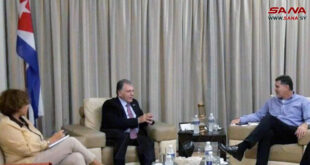Damascus, SANA – The team of archaeological experts has successfully completed their mission to inspect the systematic destruction and devastation that the ISIS terrorists inflicted upon the archaeological artifacts of Palmyra National Museum and in the ancient city as well as the possibility of being restored.
The team included local archaeologists from the Directorate General of Antiquities and Museums in cooperation with two Polish experts specialized in the restoration of statues and members of one of the archaeological missions worked in Palmyra City.
Director of Museums Affairs of the Directorate-General of Antiquities and Museums, Ahmad Deeb said that the one-week visit aimed at inspecting the destruction caused by the ISIS terrorists and estimating the damage inflicted on the archeological statues and tombs which the Directorate couldn’t move due to their large size, noting that 400 statues and stone heads as well as hundreds of archaeological artifacts were moved to safe areas.
Deeb highlighted the large-scale destruction caused to the Museum’s structure and the tower tombs south to Palmyra city is high, adding that 80% of the archaeological ruins are in good condition including the Theatre and the Street of Columns.
Regarding the damage wreaked to the Temple of Bel and Baal Shamin Temple, he said that the two temples were severely and completely demolished despite their walls are still standing, noting that they can be restored since 70 % of their stone structure still intact.
On Palmyra Castle, Deeb noted that the eastern side of the Castle and parts of its internal building were destroyed, yet it can be restored.
A specialized team continues the documentation process and makes a list of the Museum’s contents, stolen relics and damaged artifacts in order to launch the restoration works, said Deeb, adding that the assessment team couldn’t inspect all archaeological sites because of the explosives and landmines planted by the ISIS terrorists.
Deeb highlighted the Syrian army’s efforts in cooperation with Russian experts to clear the region, noting that once all mines are dismantled, the team will be able to give more accurate information about damage.
He referred to other archaeological sites which have been severely destroyed and subjected to illegal excavations and diggings, particularly in the northern region, al-Jazira (Upper Mesopotamia) region and Syria’ south, indicating to the several protection programs launched by the Directorate of Antiquities and Museums in cooperation with Culture Ministry and the civil community in order to preserve the ancient archaeological sites in the country.
Deeb underlined the directorate and the concerned parties’ cooperation with the International Criminal Police Organization (INTERPOL) to restore the archaeological artifacts smuggled by terrorist organizations through the Jordanian, Turkish and Lebanese borders.
He said that the Directorate-General of Antiquities succeeded to foil the selling of an Assyrian monument taken from Tal Sheikh Hamad archaeological site in London.
He noted that 99% of the Syrian ancient artifacts are in safe areas, except for Raqqa National Museum from which one thousand archaeological relics have been stolen in addition to other artifacts from Deir Atia Museum.
For his part, Bartosz Markowski, from the Polish Archaeological Center at the University of Warsaw, said that more than 200 artifacts and statues were smashed with heads and hands of statues cut off, noting that the restoration will require several years to accomplish.
He added that 130 destroyed statues were collected in order to be transferred to Damascus and restore them.
Markowski, who participated in restoring the limestone Lion of Allat in 2005, expressed anger over the damage caused on this precious archaeological treasure using hard tool.
In turn, the Polish expert Robert Zukowski said that despite the huge damage inflicted on Temple of Bel, it can be restored since the foundations are still intact, indicating that the ancient Arch of Triumph was slightly damaged which make the restoration process possible.
The two experts stressed that they will share their views with the international community in order to act appropriately, circulate information among experts who worked previously in Palmyra and hold a new meeting to mobilize capabilities and necessary funds to start restoration process of Palmyra city.
Palmyra city has been subjected to systematic devastation at the hands of the ISIS terrorists starting from demolishing the famous Lion of Allat last July, exploding the Temple of Bel and Baal Shamin Temple in August and destroying the tower tombs in September, not to mention the destruction of the Arch of Triumph in October and the transformation of Palmyra National Museum into a jail and a court. The ISIS terrorist organization’s crimes didn’t stop there, rather they committed criminal acts against Palmyra’s residents executing Researcher Khaled al-Asaad.
R. Raslan / Ghossoun
 Syrian Arab News Agency S A N A
Syrian Arab News Agency S A N A

